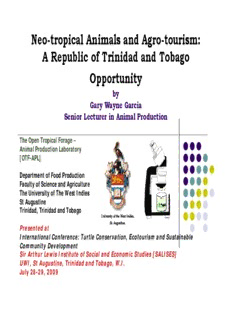
Neo-tropical Animals and Agro-tourism - The University of the West PDF
Preview Neo-tropical Animals and Agro-tourism - The University of the West
Neo-tropical Animals and Agro-tourism: AA RReeppuubblliicc ooff TTrriinniiddaadd aanndd TToobbaaggoo Opportunity by Gary Wayne Garcia Senior Lecturer in Animal Production TThhee OOppeenn TTrrooppiiccaall FFoorraaggee – Animal Production Laboratory [OTF-APL] Department of Food Production Faculty of Science and Agriculture The University of The West Indies St Augustine Trinidad, Trinidad and Tobago UUnniivveerrssiittyy ooff tthhee WWeesstt IInnddiieess,, SStt.. AAuugguussttiinnee.. Presented at International Conference: Turtle Conservation, Ecotourism and Sustainable Community Development Sir Arthur Lewis Institute of Social and Economic Studies [SALISES] UUWWII, SStt AAugusttiine, TTriiniiddadd andd TTobbago, WW.II. July 28-29, 2009 1.0 Presentation Outline 1. Where is the Neo-tropics? 2. What is meant by the term “Animal” within the context off tthhiis paper?? 3. Why the use of the term “Neo-tropical Animals” and nnoott “WWiillddlliiffee”?? 4. Utilization of Neo-tropical Animals &/ the Global Value of Wildlife. 5. Agro-tourism. 6. The problems that we have with Neo-tropical Animals. 77. NNeo-ttropiicall AAniimalls off IImporttance tto TTriiniiddadd andd Tobago within the Agro-tourism context. 8. The Opppportunities for Neo-troppical Animals in Trinidad and Tobago within the Agro-tourism context. 22.. WWhheerree iiss tthhee NNeeoo-ttrrooppiiccss?? UUnniivveerrssiittyy ooff tthhee WWWWeesstt IIIInnddddiiiieess,, SStt.. AAuugguussttiinnee.. 33. WWhhaatt iiss aann AAnniimmaall?? GGaarrcciiaa 33 XX 33 ccllaassssiiffiiccaattiioonn ooff AAnniimmaallss//LLiivveessttoocckk aass ffoolllloowwss:: 1] Domestic Animals ((i)) Food Animals (cid:122) (ii) Companion Animals (cid:122) (iii) Laboratory Animals 22] AAniimals on the Verge off Domestiicatiion [SSemii-wiild//SSemii- domesticated] 33]] ZZoooo aanndd TTrruullyy WWiilldd AAnniimmaallss This simple classification is necessary because the Vets mean one tthhiinngg, tthhee AAggrriiccuullttuurree ppeeooppllee mmeeaann oonnee tthhiinngg aanndd tthhee Conservationists mean another. 44..00 WWhhyy aarree wwee uussiinngg tthhee tteerrmm Neo-troppical Animals and not Wildlife OR Wild Animals? 4.1 Wildlife “Wildlife” includes all life that have not been domesticated byy humans “Wildlife” to mean “tteerrrreessttrriiaall aanndd aaqquuaattiicc nnoonn-ddoommeessttiicc aanniimmaallss”. At VIII International Congress on the MManagementt off WWiillddlliiffe iin AAmazoniia and Latin America, September, 2008, Acre, Brazil], it was suggested that wwee sshhoouulldd bbeeggiinn ttoo uussee tthhee tteerrmm “Neo-tropical Animals” instead of “Neo-tropical WWiillddlliiffee” oorr “AAmmaazzoonniiaann WWiillddlliiffee”. The above suggestion was made to ensure that we ddiiffffeerreennttiiaattee tthhee aapppprrooaacchheess being developed for Latin AAmeriican solutiions to “Wildlife” managgement from the Eurocentric approaches. Ojasti (1996) [pioneer on Latin American Wildlife MMaannaaggeemmeenntt, ttrraaiinneedd iinn EEuurrooppee aanndd UUSSAA bbeeffoorree ggooiinngg ttoo work in Venezuela] his thinking: “MMoosstt ooff tthhee iinnffoorrmmaattiioonn nnooww aavvaaiillaabbllee is descriptive and/or anecdotal, bbaasseedd oonn tthhee eexxppeerriieenncceess, views or beliefs of hunters and ccaammppeessiinnooss, oorr oonn nnaattuurraalliissttss’ accounts observations of animals in captivity, aanndd ssoo ffoorrtthh. TThhee ddiiffffuussee iinnffoorrmmaattiioonn iiss repeatedly cited but there is no way to chheckk iits oriigiin andd accuracy.”” ““TThhe probbllem off LLatiin AAmeriican WWiillddlliiffee rreeqquuiirreess iittss oowwnn ssoolluuttiioonnss,, geared to the specific realities of the countries, tthhe regiion andd tthhe ttype off user””.
Description: